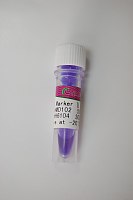Nanopore Force Spectroscopy on DNA Duplexes
互联网
695
Force spectroscopy can be applied using nanopores to study charged molecules such as nucleic acids. This technique can be used to study the binding energy of a DNA duplex by threading an anchored single-stranded DNA (ssDNA) probe molecule through a nanopore (having a diameter large enough to accommodate only a single strand) and allowing target DNA on the backside of the pore to hybridize to the probe. Electric potential can be used to apply a force to the charged ssDNA in a direction tending to translocate the duplex through the pore. If the pore is only large enough to accept ssDNA, the duplex must dissociate for the probe to escape the pore. The dissociation time of the duplex can therefore be measured under applied force, and (provided that enough dissociation events have been recorded) a characteristic time scale for dissociation can be determined. In this chapter, we present a detailed protocol for performing nanopore force spectroscopy on DNA duplexes using one or more α-hemolysin nanopores. We present the details of the measurement of the duplex survival probability under force, and show that dissociation time scales for duplexes that are perfectly complimentary differ by greater than approximately two orders of magnitude from those containing a single sequence mismatch, offering opportunities for sequence detection.






